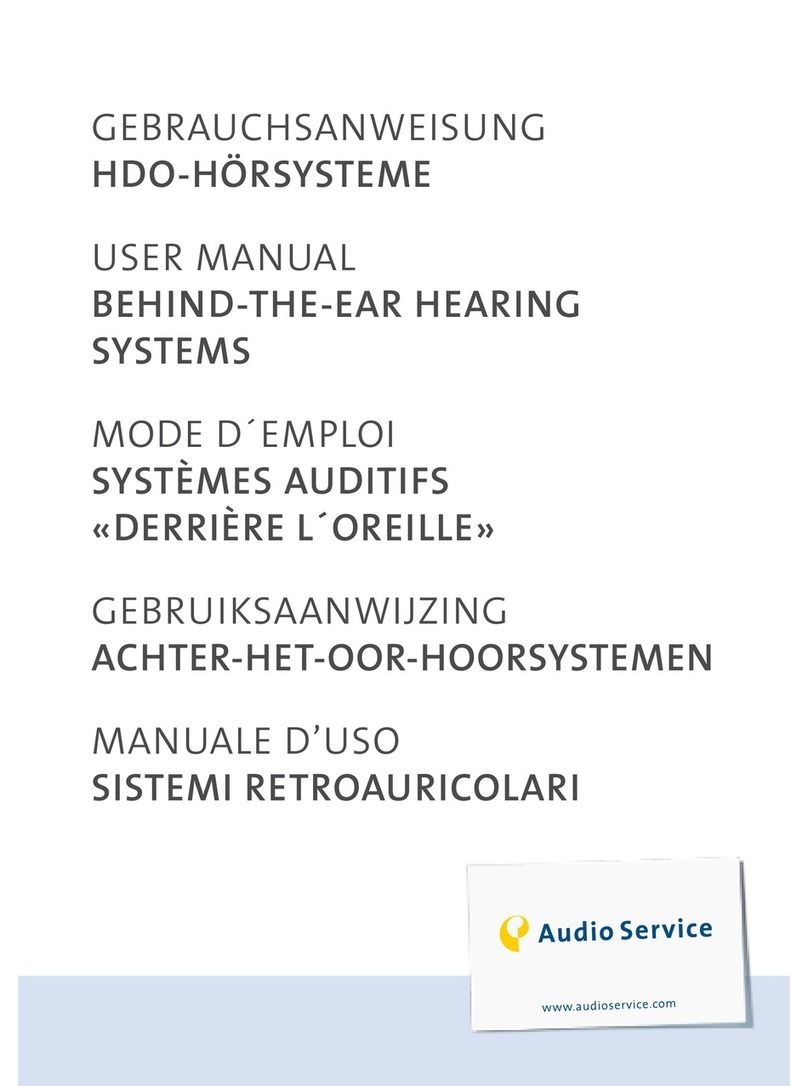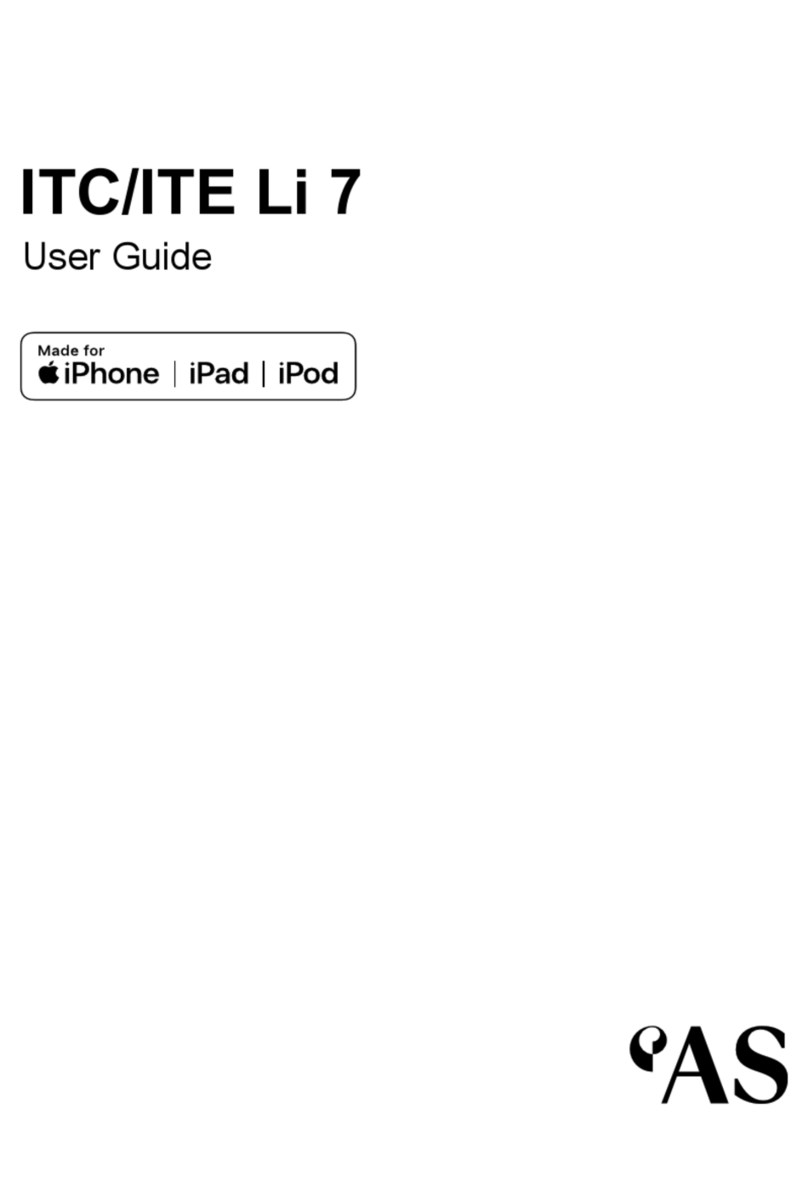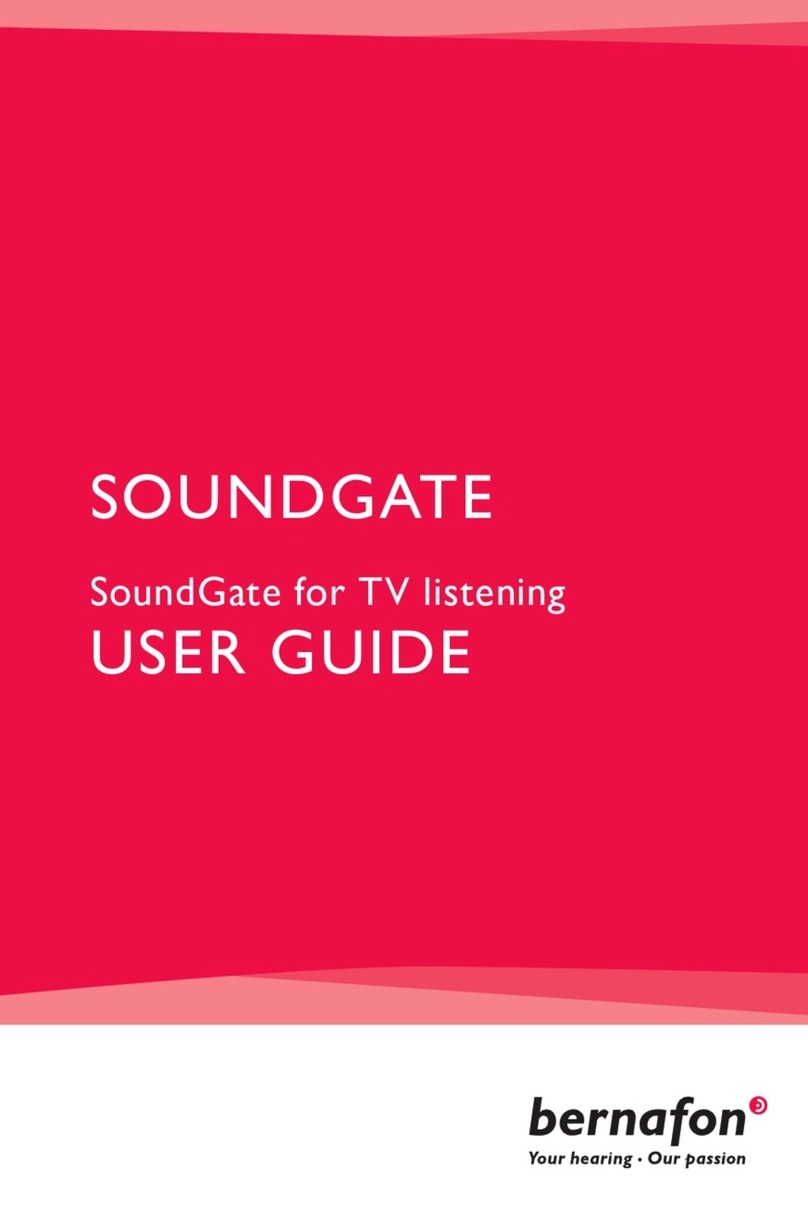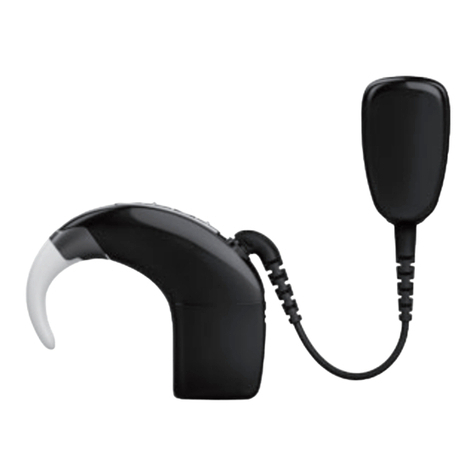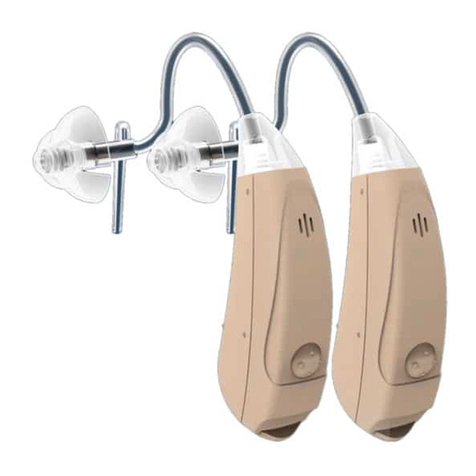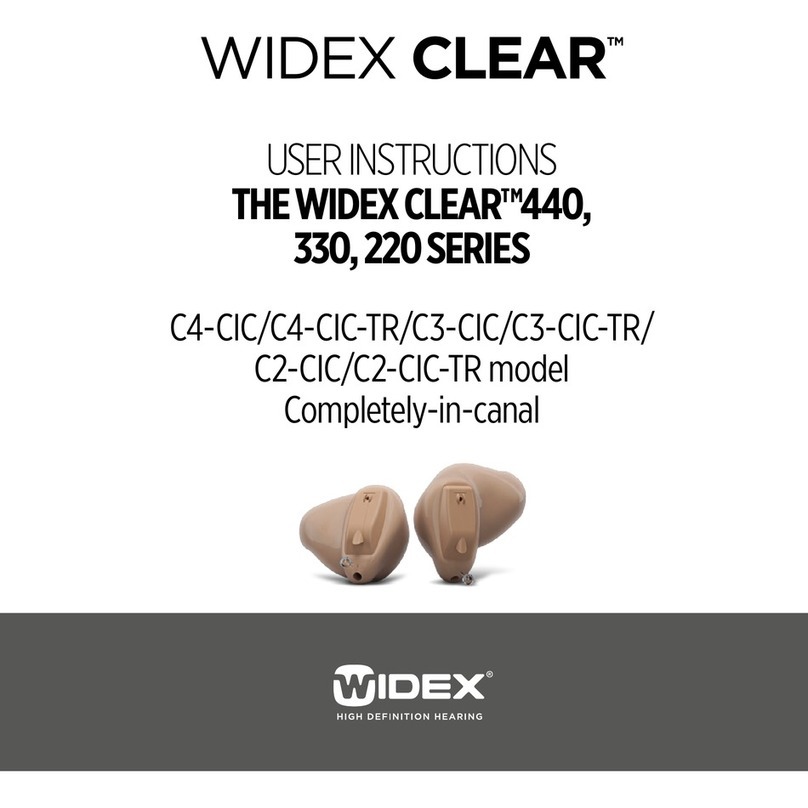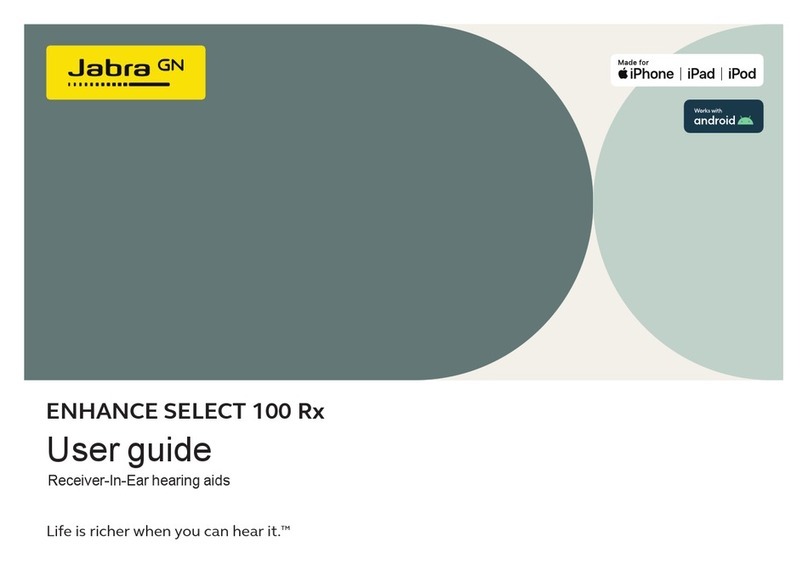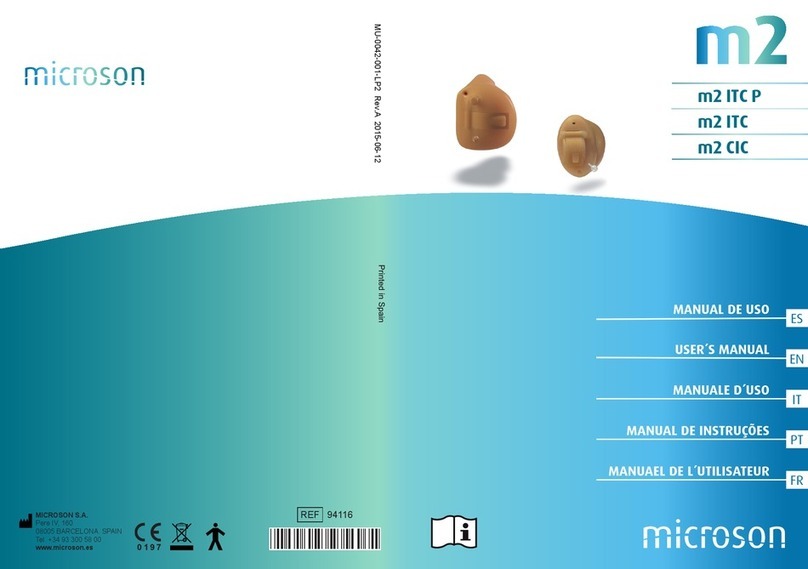Audio Service MOOD LI-ION G5 User manual

USER MANUAL
RIC – HEARING SYSTEMS
MOOD LI-ION G5

2 3
CONTENT
Welcome 4
Your hearing instruments 5
Instrument type 5
Getting to know your hearing instruments 6
Components and names 7
Controls 9
Hearing programs 10
Features 10
Daily use 11
Charging 11
Turning on and o 12
Switching to standby mode 13
Inserting and removing the hearing instruments 14
Adjusting the volume 18
Changing the hearing program 19
Further adjustments (optional) 19
Special listening situations 20
On the phone 20
Audio streaming with iPhone, iPad or iPod 21
Airplane mode 21
Maintenance and care 22
Hearing instruments 22
Ear pieces 25
Professional maintenance 27
Important safety information 28
Further information 30
Safety information 30
Accessories 30
Operating, transport and storage conditions 31
Disposal information 32
Symbols used in this document 32
Troubleshooting 33
Service and warranty 34

4 5
WELCOME
Thank you for choosing our hearing instruments to
accompany you through everyday life. Like anything new, it
may take you a little time to become familiar with them.
This guide, along with support from your Hearing Care
Professional, will help you understand the advantages and
greater quality of life your hearing instruments oer.
To receive the most benet from your hearing instruments, it
is recommended that you wear them every day, all day. This
will help you get adjusted to them.
CAUTION
It is important to read this user guide and the safety
manual thoroughly and completely. Follow the safety
information to avoid damage or injury.
Before using your hearing instruments for the rst
time, fully charge them. Follow the instructions in the
charger‘s user guide.
YOUR HEARING INSTRUMENTS
This user guide describes optional features that your
hearing instruments may or may not have.
Ask your Hearing Care Professional to indicate the
features that are valid for your hearing instruments.
INSTRUMENT TYPE
Your hearing instruments are a RIC (Receiver-in-Canal) model.
The receiver is placed within the ear canal and connected to
the instrument via a receiver cable. The instruments are not
intended for children under the age of 3 years or persons
with a developmental age of under 3 years.
A power cell (lithium-ion rechargeable battery) is
permanently built into your hearing instrument. This enables
easy charging with our inductive charger.
The wireless functionality enables advanced audiological
features and synchronization between your two hearing
instruments.
Your hearing instruments feature Bluetooth® low energy*
technology. This enables easy data transfer with your
smartphone, and for seamless audio streaming with your
iPhone, iPad or iPod**.
* The Bluetooth word mark and logos are owned by the Bluetooth SIG, Inc., and any use
of such marks by the legal manufacturer of this product is under licenses. Other trademarks
and trade names are those of their respective owners.
** iPhone, iPad and iPod are registered trademarks of Apple Inc., registered in the US and
other countries.

6 7
COMPONENTS AND NAMES
➏
➊Ear piece
➋Receiver
➌Receiver cable
➍Microphone openings
➎Push button
(control, on/o switch)
➏Side indicator
(red = right ear,
blue = left ear)
and receiver connection
GETTING TO KNOW YOUR HEARING INSTRUMENTS
It is recommended to familiarize yourself with your new
hearing instruments. With the instruments in your hand try
using the controls and note their location on the instrument.
This will make it easier for you to feel and press the controls
while wearing the hearing instruments.
If you have problems pressing the controls of your
hearing instruments while wearing them, you
can ask your Hearing Care Professional whether a
remote control or a smartphone app to control your
instruments is available.

8 9
You can use standard or custom-made ear pieces.
Standard ear pieces Size
Click Dome, Open or Closed
Click Dome Semi-open
Click Dome Double
Click Sleeve, Open or Closed
You can easily exchange the standard ear pieces. Readmore
in section„Maintenance and care“.
Custom-made ear pieces
CLIC MOULD
CONTROLS
With the push button you can, for example,
switch hearing programs. The Hearing Care
Professional has programmed your desired
functions to the push button.
Push button function L R
Press briey:
Program up
Volume up
Volume down
Tinnitus therapy signal level up
Tinnitus therapy signal level down
TV stream on/o
Press for about 2 seconds:
Program up
Volume up
Volume down
Tinnitus therapy signal level up
Tinnitus therapy signal level down
TV stream on/o
Activate/deactivate airplane mode

10 11
Push button function L R
Press for more than 3 seconds:
Turn on/o
L = Left, R = Right
You can also use a remote control to change hearing
programs and adjust the volume of your hearing
instruments. With our smartphone app you have even
more control options.
HEARING PROGRAMS
1
2
3
4
5
6
Read more in section„Changing the hearing program“.
FEATURES
The tinnitus therapy feature generates a sound to
distract you from your tinnitus.
DAILY USE
CHARGING
Place your hearing instruments in the charger.
�Follow the instructions in
the charger‘s user guide.
You can also nd useful
tips for charging in the
charger‘s user guide.
LOW POWER INDICATION
You will hear an alert signal to indicate the power cell is
running low. The signal will be repeated every 15 minutes.
Depending on the usage of your hearing instruments,
you have approximately 1.5 hours to charge your hearing
instruments before they stop working.
REPLACEMENT OF THE POWER CELL
If the fully charged hearing instruments do not last over a full
day of use (16 hours regular use without audio streaming)
then we recommend to have the power cell replaced by your
Hearing Care Professional.

12 13
TURNING ON AND OFF
You have the following options to turn your hearing
instruments on or o.
Via charger:
�Turning on: Take the instruments out of the charger.
The startup melody is played in your hearing instruments.
The default volume and hearing program are set.
�Turning o: Place the hearing instruments in the charger.
Note that the charger must be connected to the power
supply. For details refer to the charger‘s user guide.
Via push button:
�Turning on: Press and hold the push button until the
startup melody starts to play. Release the push button
while the melody is playing.
The default volume and hearing program are set.
�Turning o: Press and hold the push button for several
seconds. Depending on the settings of your push button,
signal tones may be played before the hearing instrument
turns o.
See also the tips for charging in the charger‘s user guide.
SWITCHING TO STANDBY MODE
Via remote control or smartphone app, you can switch
your hearing instruments to standby mode. This mutes the
hearing instruments. When you leave standby mode, the
previously used volume and hearing program are set.
Note:
�In standby mode, the hearing instruments are not turned
o completely. They draw some power.
Therefore we recommend to use standby mode only for a
short period of time.
�If you want to leave standby mode, but the remote control
or app is not at hand: Turn your hearing instruments o
and on again (via push button or by shortly placing them
in the charger until one or more orange LEDs light up). In
this case, the default volume and hearing program are
set.

14 15
INSERTING AND REMOVING THE HEARING
INSTRUMENTS
Your hearing instruments have been ne-tuned for your right
and left ear. Colored markers indicate the
side:
�red marker = right ear
�blue marker = left ear
Inserting a hearing instrument:
�When using Click Sleeves:
Ensure that the curve of the Click Sleeve corresponds with
the bend in the receiver cable.
Correct:
Incorrect:
�Hold the receiver cable at the bend closer to the ear piece.
�Carefully push the ear piece in the
ear canal ➊.
�Twist it slightly until it sits well.
Open and close your mouth to
avoid accumulation of air in the
ear canal.
�Lift the hearing instrument and
slide it over the top of your ear ➋.
CAUTION
Risk of injury!
�Insert the ear piece carefully and not too deeply
into the ear.
�It may be helpful to insert the right hearing
instrument with the right hand and the left hearing
instrument with the left hand.
�If you have problems inserting the ear piece,
use the other hand to gently pull your earlobe
downwards. This opens the ear canal and eases
insertion of the ear piece..

16 17
The optional retention strand helps to securely retain the ear
piece in your ear. To position the retention strand:
�Bend the retention strand and position
it carefully into the bottom of the bowl
of your ear (refer to the picture).
Removing a hearing instrument:
�Lift the hearing instrument
and slide it over the top of your
ear ➊.
�If your hearing instrument is
equipped with a custom shell
or a CLIC MOULD, remove it by
pulling the small removal cord
toward the back of your head.
�For all other ear pieces: Grip the receiver in the ear canal
with two ngers and pull it carefully out ➋.
Do not pull the receiver cable.
CAUTION
Risk of injury!
�In very rare cases the ear piece could remain in your
ear when removing the hearing instrument. If this
happens, have the ear piece removed by a medical
professional.
Clean and dry your hearing instruments after usage.
Read more in section„Maintenance and care“.

18 19
ADJUSTING THE VOLUME
Your hearing instruments automatically adjust the volume to
the listening situation.
�If you prefer manual volume adjustment, press the push
button briey or use a remote control.
Refer to section„Controls“ for the setting of the push
button.
An optional signal tone can indicate the volume change.
Once the maximum or minimum volume has been reached,
you may hear an optional signal tone.
CHANGING THE HEARING PROGRAM
Depending on the listening situation, your hearing
instruments automatically adjust their sound.
Your hearing instruments may also have several hearing
programs which allow you to change the sound, if needed.
An optional signal tone can indicate the program change.
�To change the hearing program, press the push button
briey or use a remote control.
Refer to section„Controls“ for the setting of your controls.
Refer to section„Hearing programs“ for a list of your hearing
programs.
The default volume is applied.
FURTHER ADJUSTMENTS OPTIONAL
The controls of your hearing instruments can also be used to
change, for example, the tinnitus therapy signal level.
Refer to section„Controls“ for the setting of your controls.

20 21
SPECIAL LISTENING SITUATIONS
ON THE PHONE
When you are on the phone, hold the
telephone receiver slightly above your ear.
The hearing instrument and telephone
receiver have to be aligned. Turn the
receiver slightly so that the ear is not
completely covered.
TELEPHONE PROGRAM
You may prefer a certain volume when using the phone.
Ask your Hearing Care Professional to congure a telephone
program.
�Switch to the telephone program whenever you are on
the phone.
If a telephone program or the automatic program switch
are congured for your hearing instruments, it is listed in
section„Hearing program“.
AUDIO STREAMING WITH iPHONE, iPAD OR iPOD
Your hearing instruments are Made for iPhone | iPad | iPod
hearing instruments. This means that you can transfer phone
calls or music from your iPhone, iPad or iPod directly to your
hearing instruments.
For more information about compatible iOS devices, pairing,
audio streaming and other useful functions, contact your
Hearing Care Professional.
AIRPLANE MODE
In areas where the use of Bluetooth technology is not
allowed (e.g. on some airplanes), you can activate the
airplane mode. This turns Bluetooth in your hearing
instruments o temporarily. The hearing instruments still
work without Bluetooth, however direct audio streaming will
not be possible and other functions will not be available.
�To activate or deactivate the airplane mode, use the
smartphone app or use the controls of your hearing
instruments.
Refer to section “Controls” for more information.
An alert tone indicates when airplane mode is activated or
deactivated.

22 23
MAINTENANCE AND CARE
To prevent damage it is important that you take care of your
hearing instruments and follow a few basic rules, which will
soon become a part of your daily routine.
HEARING INSTRUMENTS
CLEANING
Your hearing instruments have a protective coating.
However, if not cleaned regularly you may damage the
hearing instruments or cause personal injury.
�Clean your hearing instruments daily with a soft, dry
tissue.
�Never use running water or immerse the
devices in water.
�Never apply pressure while cleaning.
�Ask your Hearing Care Professional for recommended
cleaning products, special care sets, or more information
on how to keep your hearing instruments in good
condition.
DRYING
Your charger dries the hearing instruments while charging.
You can also use conventional products to dry your
hearing instruments. Ask your Hearing Care Professional
for recommended drying products and for individual
instructions on when to dry your hearing instruments.
STORAGE
�Short-term storage (up to several days): Turn o your
hearing instruments via the push button or place them in
the powered charger.
The charger must be connected to the power supply. If
the charger is not connected to power supply and you
place your hearing instruments in the charger, the hearing
instruments are not turned o.
Note that when you turn o the hearing instruments
via a remote control or smartphone app, the hearing
instruments are not turned o completely. They are in
standby-mode and still draw some power.

24 25
�Long-term storage (weeks, months, ...): First, fully charge
your hearing instruments. Turn them o via the push
button before storing them. We recommend using drying
products while storing the hearing instruments.
At 6 month intervals you will have to charge the hearing
systems to avoid an unrecoverable deep-discharge of
the power cell. Deep-discharged power cells cannot
be charged anymore and they have to be replaced. We
recommend recharging more frequently than 6 month
intervals.
Observe the storage conditions in section„Operating,
transport and storage conditions“.
EAR PIECES
CLEANING
Cerumen (ear wax) may accumulate on the ear pieces.This
may aect sound quality. Clean the ear pieces daily.
For all types of ear pieces:
�Clean the ear piece
right after removal
with a soft and dry
tissue.
This prevents that
cerumen becomes
dry and hard.
For Click Domes or Click Sleeves:
�Push the tips of the ear pieces together.

26 27
EXCHANGING
Exchange standard ear pieces approximately every three
months. Replace them sooner if you notice cracks or other
changes. The procedure for exchanging standard ear pieces
depends on the type of ear piece. In section„Components
and names“, your Hearing Care Professional has marked your
type of ear piece.
EXCHANGING CLICK DOMES
�To remove the old Click Dome, use the removal tool
or follow the instructions on the packaging of the
Click Domes. Be careful not to pull the receiver cable.
The removal tool is available as an accessory.
�Take particular care that
the new Click Dome clicks
noticeable in place.
�Check the rm t of the new
Click Dome.
clic
k
EXCHANGING CLICK SLEEVES
�Turn the Click Sleeve inside
out.
�Hold the Click Sleeve and
the receiver (not the receiver
cable) tightly with your ngers
and pull the Click Sleeve o.
�Take particular care to ensure
that the new Click Sleeve clicks
noticeably into place.
PROFESSIONAL MAINTENANCE
Your Hearing Care Professional can perform a thorough
professional cleaning and maintenance.
Custom-made ear pieces and wax lters should be
exchanged as needed by your Hearing Care Professional.
Ask your Hearing Care Professional for your individual
recommendation of maintenance intervals and for support.
click

28 29
IMPORTANT SAFETY INFORMATION
This section contains important safety information regar-
ding the power cell. For more safety information, refer to the
safety manual supplied with the hearing instruments.
WARNING
A power cell (lithium-ion rechargeable battery) is
permanently built into your hearing instrument.
Incorrect use of the power cell or the hearing
instrument can cause the power cell to burst.
Risk of injury, re or explosion!
�Follow the safety instructions for power cells in this
section.
�Observe the operating conditions. Refer to section
„Operating, transport and storage conditions“.
�Pay special attention to protect your hearing instruments
from extreme heat (e.g. re, microwave oven, inductive
oven or other high-induction elds) and sunlight.
�Charge your hearing instruments only with the approved
charger. Ask your Hearing Care Professional for support.
�Do not disassemble the power cell.
Replacement and repair have to be performed by a
professional. Therefore:
�Do not repair or replace the power cell yourself.
�Do not use the hearing instruments when their
performance after charging reduces considerably.
�In the unlikely event of a power cell bursting or exploding,
keep all combustible parts away.
In any of the above cases, return your hearing instruments to
the Hearing Care Professional.

30 31
FURTHER INFORMATION
SAFETY INFORMATION
For more safety information, refer to the safety manual
supplied with the device.
ACCESSORIES
You can use the Smart Direct App for convenient remote
control of your hearing instruments. The app also allows you
to deactivate signal tones, to create individual sound proles
and many more functions.
You can also use a remote control.
The hearing instruments support CROS and BiCROS solutions
for the unilaterally deaf.
Consult your Hearing Care Professional for further
information.
OPERATING, TRANSPORT AND STORAGE
CONDITIONS
Operating conditions Discharging Charging
Temperature 0 to 50 °C 10 to 35 °C
Relative humidity 5 to 93 % 5 to 93 %
During extended periods of transport and storage, please
observe the following conditions:
Storage Transport
Temperature 0 to 25 °C -20 to 60 °C
Relative humidity 20 to 80 % 5 to 90 %
Note that you have to charge the hearing instruments at least
every 6 months. For details refer to section„Maintenance and
care“.
For other parts, such as the charger, other conditions may
apply.
WARNING
Risk of injury, re or explosion during shipment.
�Ship power cells or hearing instruments according
to local regulations.

32 33
DISPOSAL INFORMATION
�To avoid environmental pollution, do not throw power
cells or hearing instruments into household trash.
�Recycle or dispose of power cells or hearing instruments
according to local regulations.
SYMBOLS USED IN THIS DOCUMENT
Points out a situation that could lead to serious,
moderate, or minor injuries.
Indicates possible property damage.
Advice and tips on how to handle your device better.
“Made for iPhone”, “Made for iPad”
and “Made for iPod”mean that the device was developed
specially for use with iPhone, iPad or iPod and has been
certied by the developer as fullling Apple performance
standards. Apple is not responsible for the operation of
this device or its compliance with safety and regulatory
standards. Please note that use of this accessory with an
iPhone, iPad or iPod may aect wireless performance.
TROUBLESHOOTING
Problem and possible solutions
Sound is weak.
�Increase the volume.
�Charge the hearing instrument.
�
Clean or exchange the ear piece.
Hearing instrument emits whistling sounds.
�Reinsert the ear piece until it ts securely.
�Decrease the volume.
�
Clean or exchange the ear piece.
Sound is distorted.
�Decrease the volume.
�Charge the hearing instrument.
�
Clean or exchange the ear piece.
Hearing instrument emits signal tones.
�Charge the hearing instrument.
Hearing instrument does not work.
�Turn the hearing instrument on.
�Charge the hearing instrument. Observe also the
status LEDs on the charger.
Consult your Hearing Care Professional if you encounter
further problems.

34 35
SERVICE AND WARRANTY
Serial numbers Instrument Receiver unit
Left:
Right:
Service dates
1: 4:
2: 5:
3: 6:
Warranty
Date of purchase:
Warranty period in months:
Your Hearing Care Professional
NOTES

Art. No. 109 60 846 / V1 · 09.2018 · Subject to technical modifications. Errors excepted.
AS AUDIO-SERVICE GmbH
Alter Postweg 190 · 32584 Löhne · Germany
www.audioservice.com
Table of contents
Other Audio Service Hearing Aid manuals

Audio Service
Audio Service STILINE BT User manual
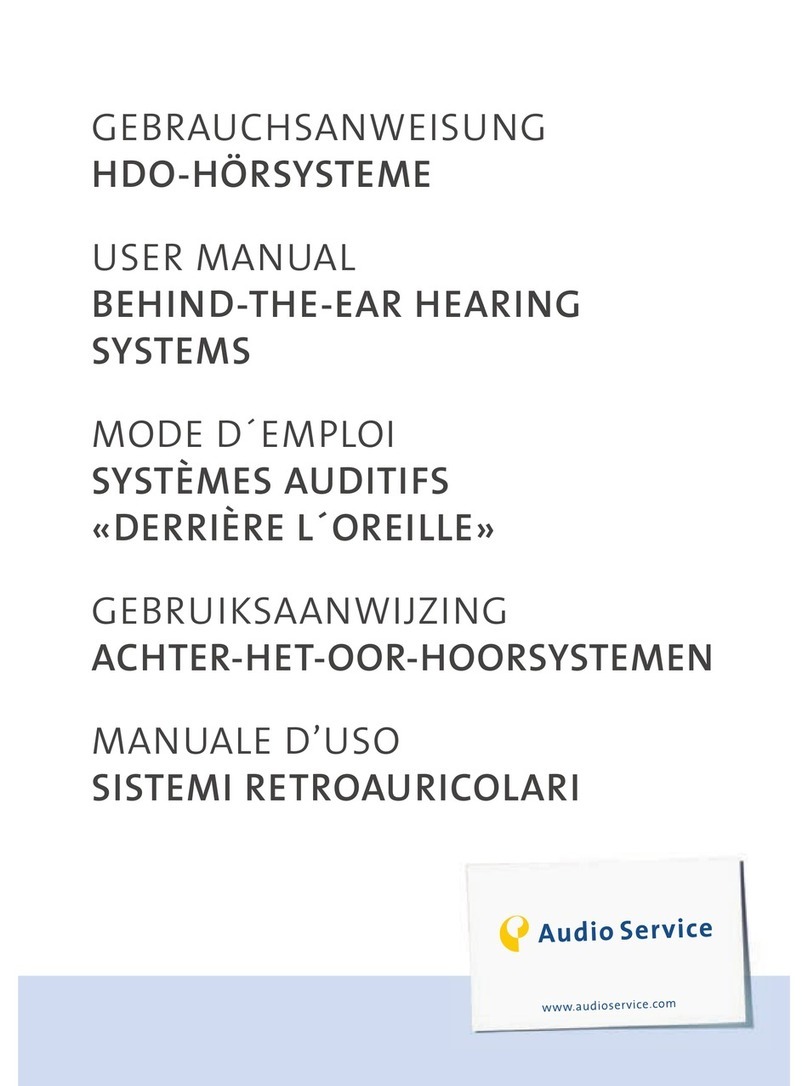
Audio Service
Audio Service NOVA 2 + ASTRAL User manual
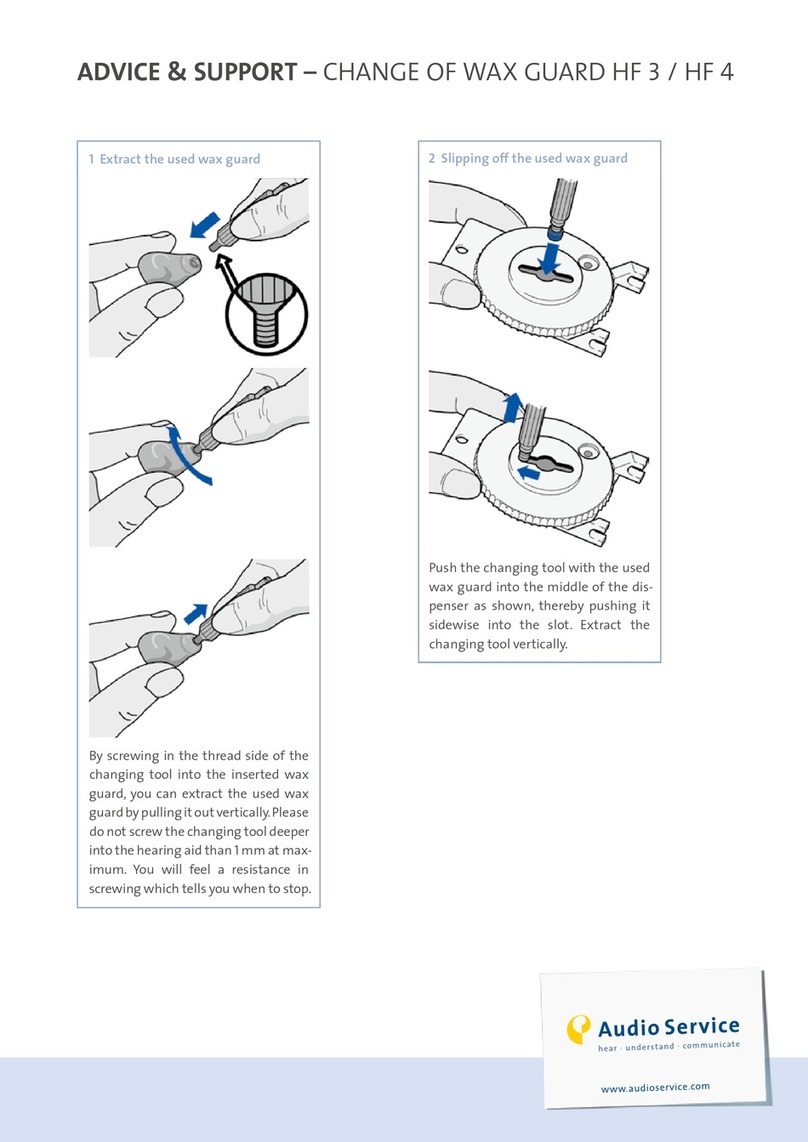
Audio Service
Audio Service HF 3 User manual
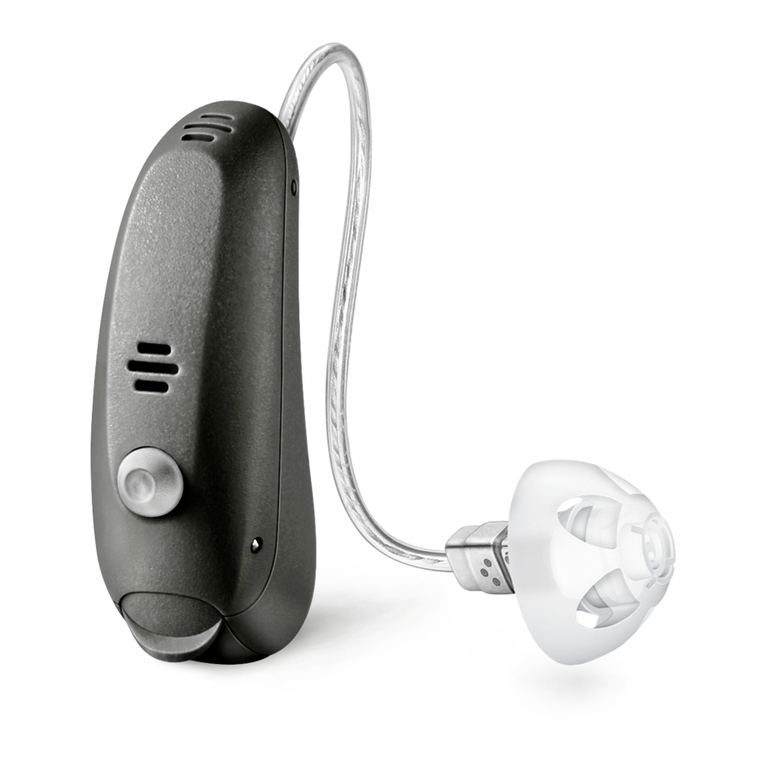
Audio Service
Audio Service Rixx 8 G2 User manual

Audio Service
Audio Service Mood Li-Ion G6 User manual
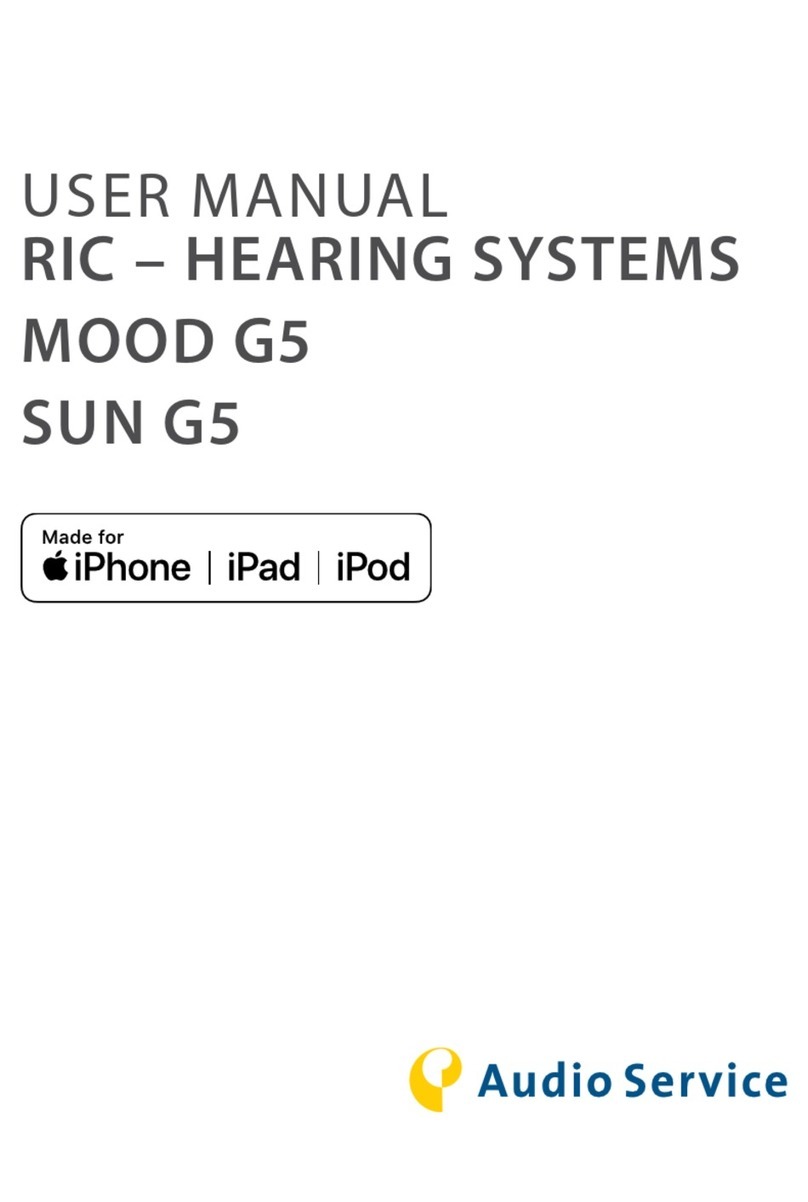
Audio Service
Audio Service Mood G5 User manual
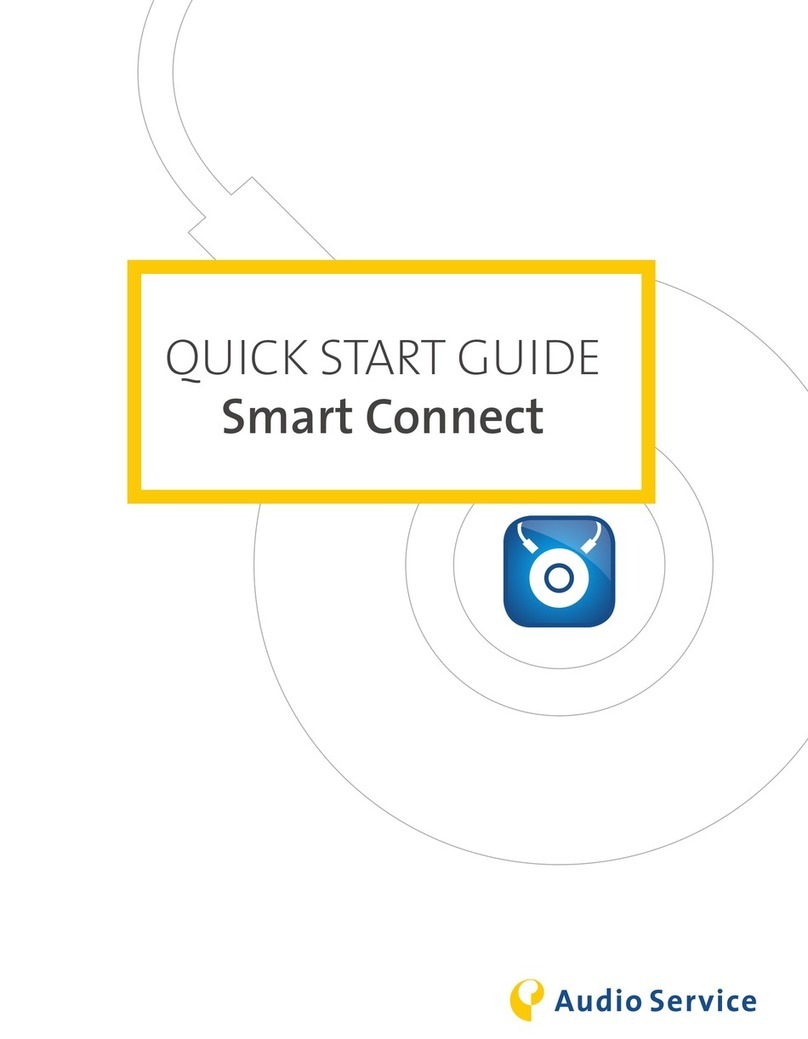
Audio Service
Audio Service Smart Connect User manual
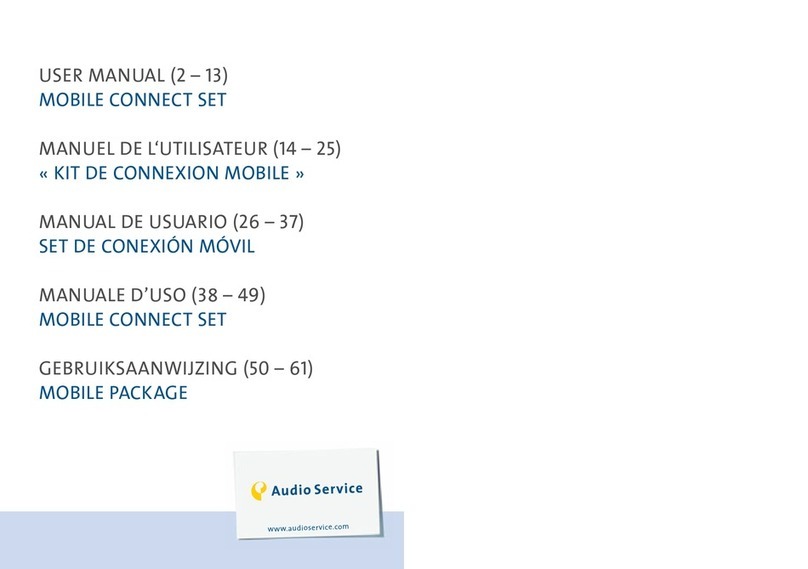
Audio Service
Audio Service Mobile Connect Set User manual
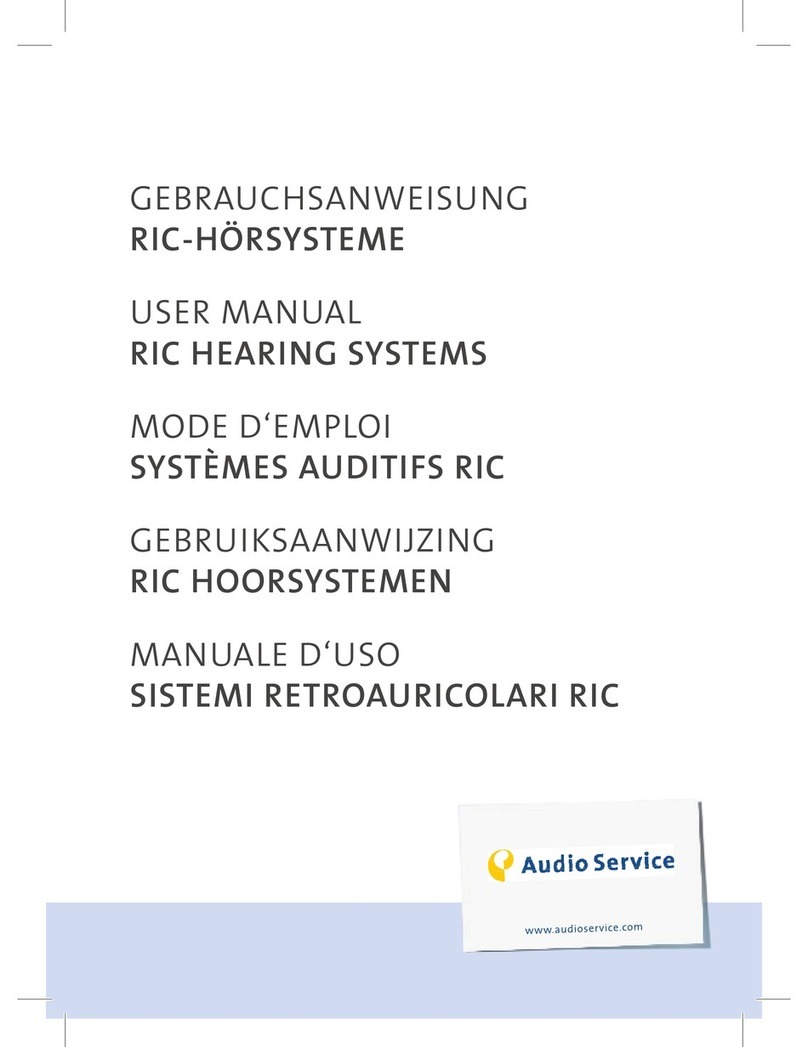
Audio Service
Audio Service RIC RIXX G2 User manual

Audio Service
Audio Service SUN G3 User manual
